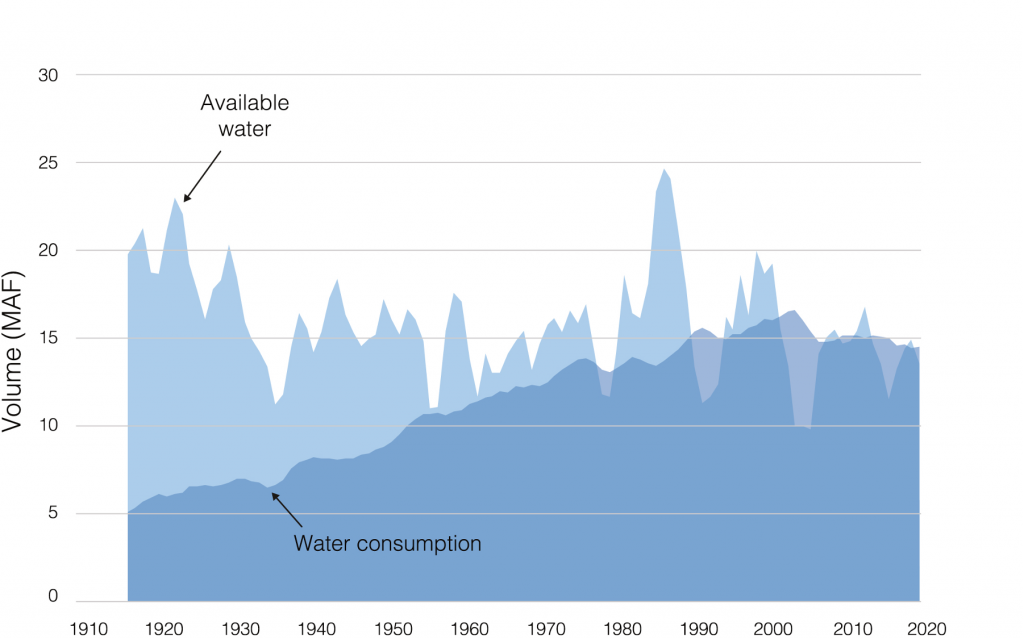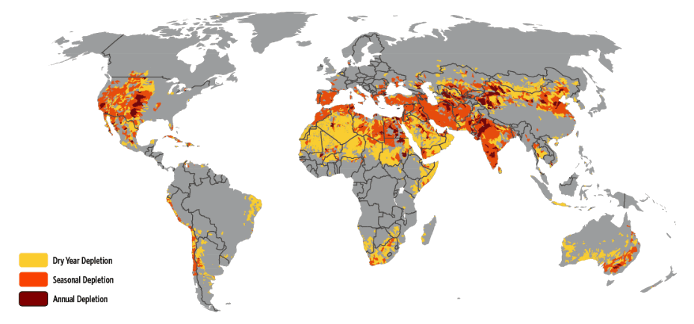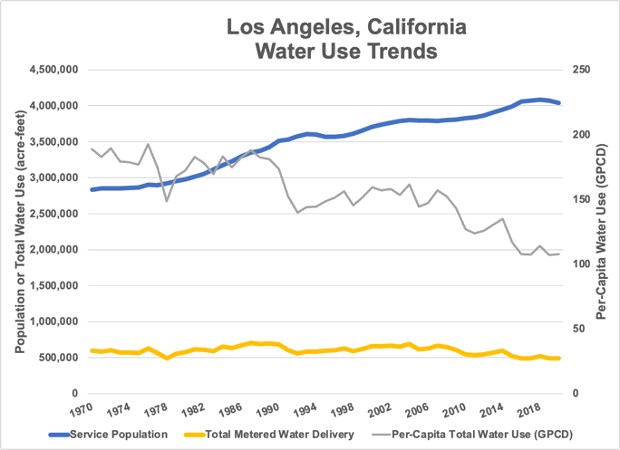BLOG
June 10th, 2021
Via Sustainable Waters, commentary on common misconceptions about water security:
Seems like every day brings another news story about the water crisis in the Western US.
Never in my lifetime have I seen such an intense drought spanning such a wide geographic sweep: from West Texas to the Rio Grande to the Colorado River to the Central Valley of California to the Klamath River in Oregon.
It’s really important for this story to get a lot of media attention, because publicity can help provoke the big changes that desperately need to happen with water management in the West. But it’s also critically important that reporters get this story straight, so that their readers will understand how we got into this mess, and how we can move toward a more secure and sustainable water future.
Here’s a few key points, addressing some of the most common misconceptions about water scarcity.
#1. Droughts Don’t Cause Water Scarcity. People Do.
By definition, water scarcity is human-driven; it is a function of the volume of water consumed by humans relative to the volume of accessible, affordable water resources in a given area. As such, an arid region with very little water but no human water consumption would not be considered “water scarce,” but rather simply “arid.” Similarly, droughts do not in themselves cause scarcity; instead, scarcity and associated water shortages occur when human demands for water are greater than what is available at any given time. Simple supply and demand logic.
Your bank account is a very good analog. If you are always spending virtually all of the money you deposit, you are highly vulnerable to overdraft when (1) you aren’t depositing as much money, such as when you experience an interruption of your income; or (2) you have a need to spend more, such as to pay a hefty doctor’s bill. If you don’t have enough money in your savings account to cover your overdraft, you go bankrupt (or at least bounce a few checks).
Therefore, focusing only on the supply (deposit) side — the lessened availability of water during a drought — is only half the scarcity story. It’s very important to tell the other half, which is that our consumption (spending) has become too high relative to water availability.
From my analyses of the emergence of scarcity in many places around the globe, it’s quite obvious that a community’s vulnerability to water shortages increases greatly as human dependence on a particular water supply such as the Colorado River is allowed to grow to the limits of the natural, renewable water supply. A city or farming district might get by pretty well during normal or wet years, but when drier times eventually come, somebody doesn’t get the water they need and water-dependent ecosystems suffer.
The graph below illustrates this very well, and the map below shows the places in the world where water consumption has been approaching the limits of water supplies.
Virtually all of the water flowing in the Colorado River was being consumed during the mid-1950s drought, yet consumption was allowed to increase, largely without constraint. Consumption now exceeds annual river flows in most years; the overdraft is accommodated by pulling water out of storage reservoirs such as Lake Mead. Those reservoirs are being rapidly depleted, placing the communities and businesses dependent upon the river at great risk of water shortages. (Data source: US Bureau of Reclamation. MAF=million acre feet)
This map highlights the places around the globe that are experiencing water shortages. Yellow areas on the map represent places that experience water shortages during droughts, orange areas experience scarcity during certain months of the year, and red areas are chronically short of water. Water scarcity presently affects half of the world’s population and three-fourths of all irrigated agriculture. (Map and statistics from Brauman and others, 2016)
#2. Don’t Blame This on the Cities
Tim Egan of the New York Times, when writing about the Colorado River last month, got it right: “….Vegas, and other oasis metropolises like Los Angeles, Phoenix and Tucson, are not the problem.”
He’s right for two important reasons: (1) urban water uses — including residential, commercial, and industrial uses — account for only 11% of all water consumption in the West; and (2) urban water use has been declining since the 1980s.
There are many examples of water-guzzling urban areas, particularly smaller towns and ‘exurbs’ of large metropolitan areas, but in general the big cities of the West have been doing a phenomenal job of actually lowering their water use even while their populations have grown rapidly. Our research, published last year in the international Water journal, documented that on average, Western US cities have grown by 21% while their water use has decreased by 19% during the past two decades.
Los Angeles is a terrific example of a high-performing water conservation city, as shown in the graph below.
Over the past 50 years, the City of Los Angeles has been able to reduce its total water use by 23% even while its population grew by 43%. The City was able to accomplish this largely by incentivizing its residents to reduce their per-capita water use by more than 40%. (Data and statistics from Richter and others, 2020)
#3. Water Scarcity Isn’t a New Story
Some communities in the Western US have been struggling with water scarcity — and experiencing water shortages — for more than 100 years. We developed the animation below (click to activate) to illustrate the fact that many areas around the world, including much of the Western US, have been bumping up against the limits of their natural renewable water supplies for a very long time. This animation highlights places where total water consumption nearly equaled (or exceeded) water availability in each year.
This animation and the scarcity hot spots highlighted here are based solely on agricultural water consumption — it does not include any additional water consumed by cities or industries. Irrigated agriculture has always accounted for the lion’s share of water consumption in the West; even today it accounts for 86% of all water consumed. Many Western rivers were being heavily diverted for irrigation by the latter half of the 19th century, when farmers needed to feed massive waves of new settlers rushing to gold fields in California, Montana, and the Black Hills of South Dakota, and federal Homestead Acts gave free land to those willing to farm it.
Yes, farming is a very water intensive industry but it would not be appropriate to blame farmers for our water scarcity either. It simply takes a lot of water to produce food for our families, our country, and people around the world.
There are certainly too many farmers that use water wastefully, but the same can be said for city-dwellers. If there’s anyone to blame here, it should be directed at those that were entrusted to manage water on our behalf.
#4. Water Scarcity is a Failure of Governance
Elinor Ostrom won the Nobel Prize in Economic Sciences in 2009 in large part for her insightful work on “Governing the Commons.” Ostrom resisted the premise that shared (‘common pool’) resources would always fall victim to the tragedy of the commons, i.e., become over-exploited. Ostrom highlighted examples of communities, such as the Philippine irrigation farmers known as zanjeras, that manage their shared resources in communal fashion, such as by allowing each farmer to take a proportional share of the available water each year.
When I was writing the governance chapters of my Chasing Water book in 2014, I looked very hard to find other examples of successful communal water governance. In my book I wrote about the acequia irrigation systems brought to Mexico and the American Southwest by the Spaniards. But there are preciously few other good examples, and none at the scale of a large river basin.
Instead, most state and federal governments have taken a regulatory approach to water governance, specifically the prior appropriation system managed by state governments in the Western US. Under this system, state governments hold the water in trust and issue rights to use water to individuals, companies, water utilities, electricity producers, irrigation districts, and other water users.
The fatal flaw in this approach was that states issued far more water rights than the water flowing in their rivers. California, for example, has issued five times more rights than the mean volume of river water available! And as I pointed out in the graph above of the Colorado River, state regulators continued issuing more and more water rights even after the river had been almost completely drained by the mid-1950s.
It is a treacherously difficult and politically contentious challenge to try to get the cows back in the barn after they’ve busted loose. It takes strong courage for a politician or water regulator to take back some of the water that people have become accustomed to, and are financially dependent upon.
But some hopeful signs of leadership are emerging. In 2014, California passed a Sustainable Groundwater Management Act that requires sufficient reduction in pumping to stabilize aquifer levels; SGMA could result in 20% of farmland being taken out of production unless farmers can find other ways to reduce their water use. In 2019, the ‘Lower Basin’ states of California, Nevada, and Arizona that share the Colorado River agreed to curtailments in water use by as much as 20% of their current use, as needed to stabilize Lake Mead.
#5. It’s Time to Start Talking About the Long Game for Water in the West
Taking bold political steps to set a limit, or a cap, on the volume of water that can be taken from any particular river or aquifer is a very important place to begin the journey toward a secure and sustainable water future.
However, it is a far more daunting challenge to figure out how to live within those limits.
It’s understandable why reporters are drawn toward sensational stories of pain and loss during a water crisis like the one the West is experiencing. But crisis brings extraordinary opportunities as well. Let’s not squander this opportunity to begin vigorously designing a more sustainable and secure water future. I hope that media reporters will increasingly feature stories about the ways that cities and farmers and industries are adapting to water scarcity and climate change in progressive ways, rebalancing their overdrawn water budgets. What are the innovative ideas and practices and changes that we need to implement to get us out of trouble?
Stay tuned. I intend to continue telling some of those stories myself.




